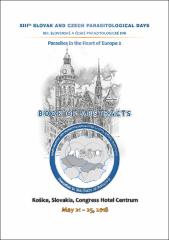Prevalence of Dirofilaria spp. in the Balkan Region

View/
Date
2018Author
Savić, Sara
Otašević, Suzana
Žekić-Stošić, Marina
Potkonjak, Aleksandar
Silaghi, Cornelia
Metadata
Show full item recordAbstract
Dirofi lariosis is a parasitic mosquito borne disease in carnivores. During the last 20 years the disease has spread
over the Balkan peninsula and some regions became endemic for dirofi alriosis. The disease is spread and
transferred by the mosquitoes and dogs are considered as reservoirs. Mosquitoes that can carry microfi lariae and
transfer the disease in the region are mostly Culex (С.) pipiens biotype molestus or Aedes (А.) vexans. In a study
on vector competence for D.immitis, it has been concluded that Culex pipiens biotype molestus, the most prevalent
mosquitoe in the region, are not the most competent vectors due to their size and inability to bear high number
of microfi lariae. Aedes mosquitoes are more tolerant to the presence of microfi laria, which makes them more
competent vectors. So far, the presence of Dirofi laria in mosquitoes has been confi rmed in several Balkan countries
so far, but the prevalence of the causative agent in different mosquito species is not yet known.
The disease has been discovered primeraly in dogs, becasue of the most obvieus clinical symptoms. Canine
dirofi lariosis can be found in 2 forms – subcutaneous dirofi lariosis cause by Dirofi alria repens and cardiopulmonal
dirofi alriosis cause by Dirofi laria immitis („heart worm“). In skin form there are hardly any symptoms, while in heart
form of the disease, cardiopulmonal symptoms can be found which could potencially lead to a fatal outcome.
Prevalence of D.immitis and D.repens in infected dogs in the Balkan region is from 3-20% and from 2-40%
respectively, depending on the region and on the investigated group (with or without clinical symptoms).
During the past several years, dirofi lariosis in humans is more and more diagnosed and reported. Until today,
mostly subcutaneous and subconjunctival localization of Dirofi laria is found caused only by Dirofi laria repens.
Prevalence of D.repens infection in humans from the Balkan region (with the exception of Greece which had higher
prevalence) was from 1-13% before 2000. and from 1-35% in 2000-2014 period.
Diagnostics of dirofi lariosis due to D.immitis infections in dogs is simple, known, and comercial tests are accessible
to the vets. However, for D. repens there are no comercial kits, neither for dogs or humans, which gives the disease
the opportunity for „undetected“ disease to spread and this could have an imact to public health in the future.
